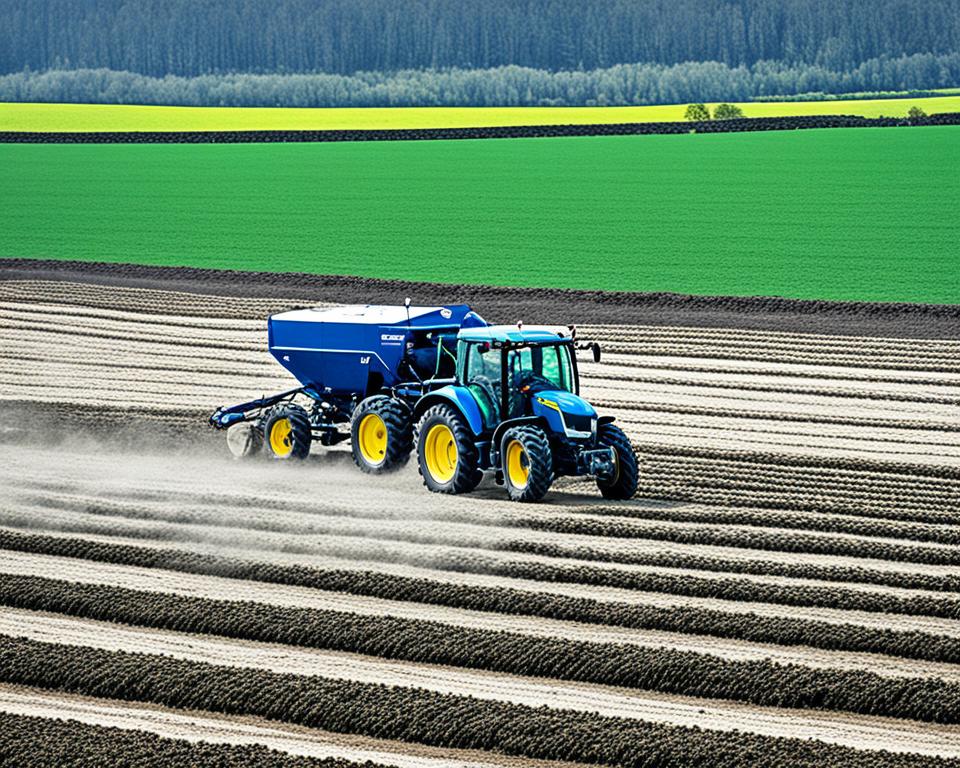Welcome to our article on the various uses of quicklime. Quicklime, also known as calcium oxide (CaO), is a versatile substance that finds application in several industries and processes. Its unique properties make it a valuable ingredient in construction, water treatment, agriculture, and various industrial applications.
Throughout this article, we will explore the different sectors where quicklime plays a pivotal role, highlighting its importance and benefits. From its role in construction projects to water treatment, agriculture, and industrial processes, quicklime has proven to be an essential ingredient for numerous applications.
Key Takeaways:
- Quicklime is a versatile substance used in multiple industries.
- It is commonly used in construction, water treatment, agriculture, and industrial processes.
- Quicklime helps in mortar and plaster production, soil stabilization, and road construction.
- It plays a crucial role in adjusting pH levels and removing impurities in water treatment.
- In agriculture, quicklime aids in soil pH adjustment, nutrient enrichment, and pest control.
Construction Uses of Quicklime
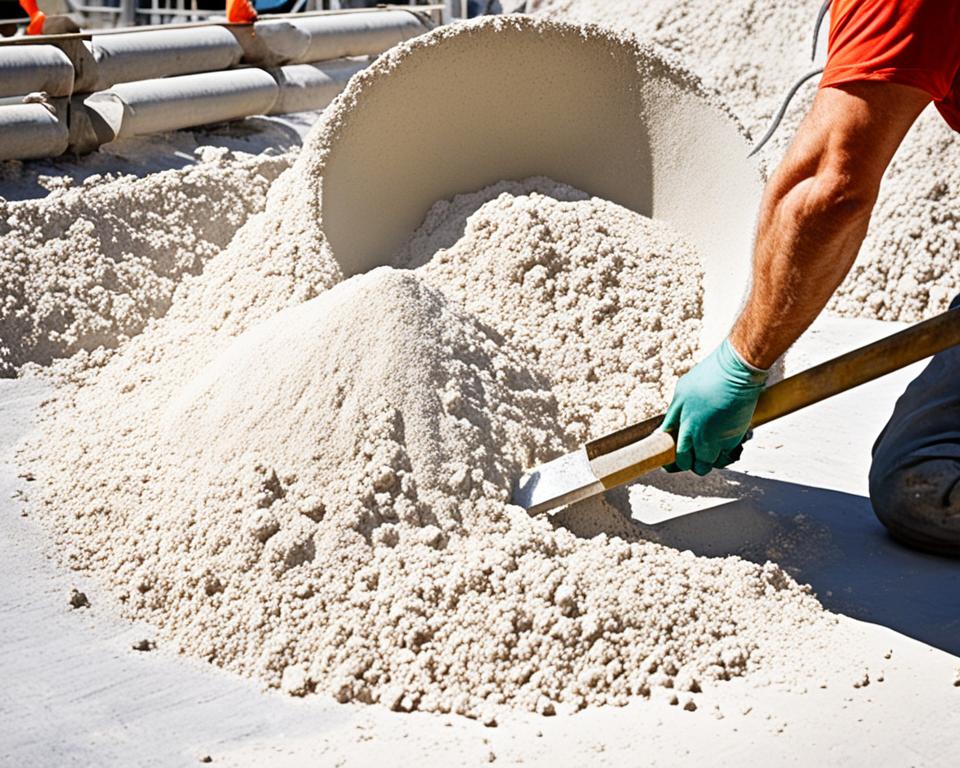
In the world of construction, quicklime plays a vital role in various applications. Its versatility and unique properties make it an invaluable ingredient in mortar and plaster production. Quicklime, also known as calcium oxide (CaO), is widely utilized due to its ability to bind and strengthen the construction materials. Let’s explore the different construction uses of quicklime in more detail.
Mortar and Plaster Production
Quicklime is a key component in the production of mortar and plaster, two essential construction materials. When quicklime is combined with water, a chemical process called hydration occurs, resulting in the formation of calcium hydroxide (Ca(OH)₂). This hydrated lime, when mixed with sand and water, forms mortar, a paste-like substance used for binding bricks or stones in construction. Moreover, quicklime can also be used to produce plaster, which is commonly used for interior walls and ceilings.
To ensure the integrity and durability of buildings, architects and builders rely on quicklime in the creation of strong and reliable mortar and plaster. Its exceptional binding properties contribute to the overall stability and longevity of construction projects.
Soil Stabilization
In addition to its role in mortar and plaster production, quicklime is widely used for soil stabilization in construction projects. By adding quicklime to soil, it undergoes a process known as soil stabilization, which improves the engineering properties of the soil, making it suitable for construction purposes.
Quicklime helps in stabilizing the soil by reducing plasticity and increasing its load-bearing capacity. It creates a stronger and more stable foundation for structures, ensuring the long-term stability of roads, buildings, and other infrastructure.
Road Construction
Quicklime also finds extensive use in road construction projects. It is commonly used for treating clayey soils, which tend to become unstable and soft during wet conditions. By incorporating quicklime into the soil, the plasticity of the clay is reduced, increasing its strength and preventing mechanical failures.
The use of quicklime in road construction not only ensures the durability and stability of the road but also reduces maintenance costs by improving the soil’s resistance to moisture. Additionally, quicklime helps in preventing the formation of potholes and rutting, providing a smoother and safer road surface for motorists.
In conclusion, quicklime plays a crucial role in construction projects. Its presence in mortar and plaster production, soil stabilization, and road construction ensures the strength, stability, and longevity of buildings and infrastructure. The unique properties of quicklime make it an indispensable material in the construction industry, contributing to the overall safety and quality of construction projects.
Water Treatment Applications of Quicklime
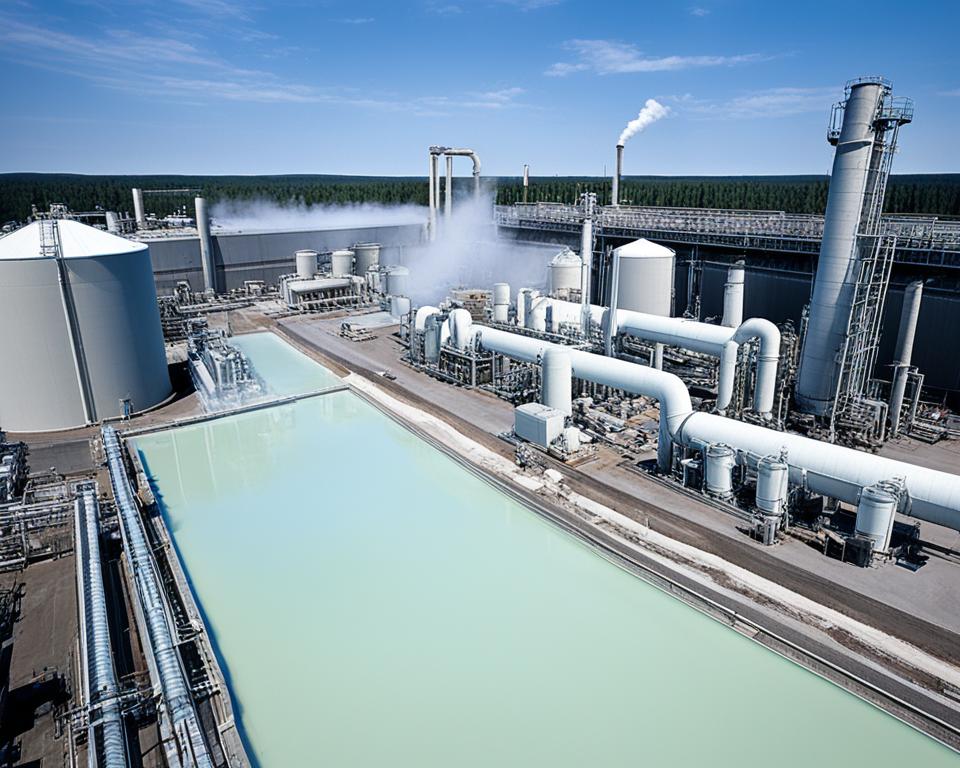
In the realm of water treatment, quicklime plays a vital role in ensuring the provision of clean, safe, and potable water to communities. With its exceptional qualities, quicklime is widely utilized in various water treatment processes, facilitating the removal of impurities and the adjustment of pH levels in both drinking water and wastewater treatment facilities.
When it comes to the purification of drinking water, quicklime acts as a powerful coagulant, aiding in the clarification and elimination of contaminants. Its alkaline nature enables the precipitation of dissolved substances such as heavy metals, organic matter, and microorganisms, resulting in cleaner and healthier water.
Furthermore, quicklime’s high reactivity allows it to effectively sterilize water by destroying pathogens and bacteria. By adjusting the pH levels, quicklime can create an environment that is inhospitable to harmful microorganisms, ensuring the safety of the water supply.
In wastewater treatment facilities, quicklime is indispensable in the elimination of pollutants and the neutralization of acidic wastewater. It facilitates the removal of phosphorus, a common pollutant in industrial and domestic wastewater, by enabling its precipitation as an insoluble compound. Additionally, quicklime can neutralize acidic wastewater, thus preventing corrosion in the treatment infrastructure.
Moreover, the use of quicklime in wastewater treatment aids in the coagulation and sedimentation of suspended solids, facilitating their removal from the water. This enhances the efficiency of subsequent treatment processes, leading to improved water quality and environmental protection.
Quicklime’s role in water treatment is crucial, as it not only helps to remove impurities but also ensures the pH levels are appropriate for safe consumption and environmental sustainability.
Benefits of Quicklime in Water Treatment:
- Effective coagulation and clarification
- Sterilization and pathogen removal
- Phosphorus removal and neutralization of acidic wastewater
- Enhanced removal of suspended solids
In conclusion, quicklime plays an integral role in water treatment applications. Its exceptional properties enable the removal of impurities, adjustment of pH levels, and enhancement of water quality. Whether it is in drinking water or wastewater treatment, the use of quicklime ensures the provision of clean water for communities and contributes to environmental sustainability.
Agricultural Uses of Quicklime

Quicklime, also known as burnt lime or calcium oxide, plays a crucial role in various agricultural applications. Its unique properties make it a versatile and valuable tool for farmers and gardeners alike. In this section, we will explore the agricultural uses of quicklime and how it contributes to soil health, nutrient enrichment, and pest control.
Soil pH Adjustment
One of the primary agricultural uses of quicklime is soil pH adjustment. Soil acidity or alkalinity can significantly impact plant growth and nutrient availability. Quicklime is commonly used to raise the pH levels of acidic soils, creating a more favorable environment for crops. By neutralizing the soil acidity, quicklime helps promote healthy plant growth and maximizes nutrient utilization.
Nutrient Enrichment
Quicklime also plays a vital role in nutrient enrichment. It reacts with organic matter or fertilizers present in the soil, releasing essential nutrients such as calcium and magnesium. These nutrients are essential for plant growth, aiding in root development, cell formation, and overall plant health. Additionally, quicklime enhances the availability of other nutrients, making them more accessible to the plants and increasing their uptake.
Pest Control
Another beneficial use of quicklime in agriculture is pest control. Quicklime has the ability to repel certain pests and insects due to its high alkalinity. When applied to the soil or used as a coating for seeds, quicklime acts as a natural deterrent, helping to prevent pest infestations. This reduces the need for chemical pesticides, resulting in a more sustainable and environmentally friendly farming practice.
Overall, quicklime offers numerous benefits in agriculture, from soil pH adjustment to nutrient enrichment and pest control. Its versatility and effectiveness make it a valuable tool for farmers and gardeners looking to optimize crop yields and promote sustainable farming practices.
Industrial Applications of Quicklime
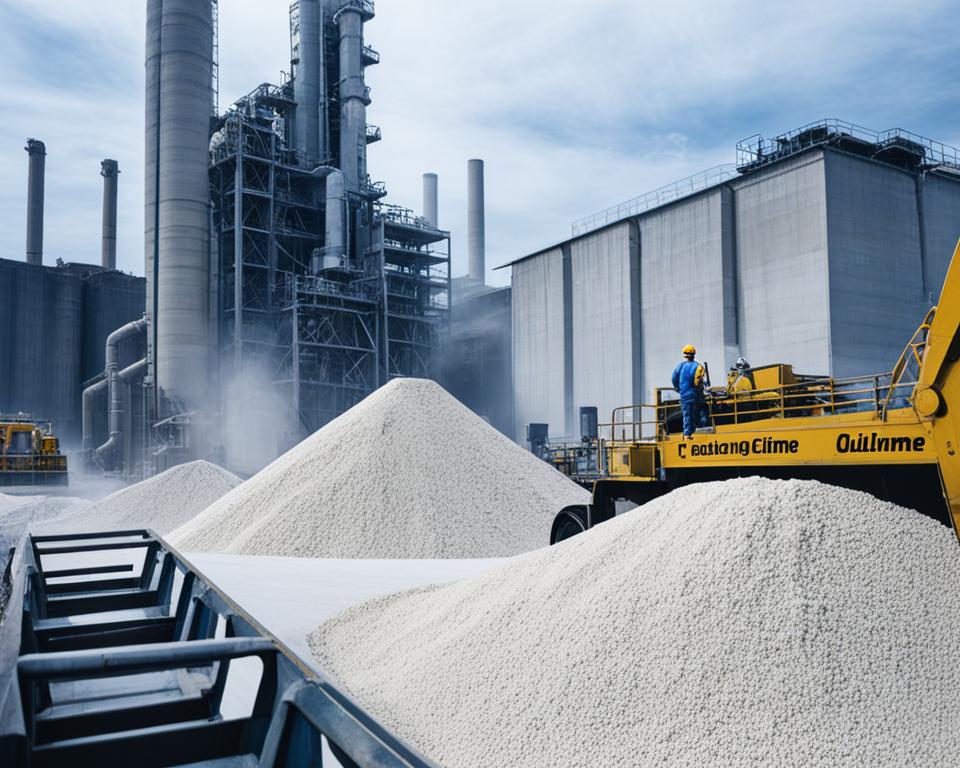
Quicklime is a versatile compound widely used in various industries for its exceptional properties. Its industrial applications span across steel manufacturing, paper production, and chemical processes.
Steel Manufacturing
In the steel industry, quicklime plays a crucial role in several processes. It is used as a fluxing agent to remove impurities from iron ore during the production of steel. Additionally, quicklime helps regulate sulfur content, ensuring the final steel product meets quality standards.
Quicklime also aids in adjusting slag composition, which facilitates the separation of impurities and maximizes the efficiency of steelmaking operations. Its high melting point and ability to withstand extreme temperatures make it a valuable asset in steel manufacturing.
Paper Production
The paper production industry heavily relies on quicklime for its various benefits. Quicklime is used in pulping processes to break down and separate lignin from cellulose fibers, resulting in high-quality pulp. This enhances paper strength and contributes to the production of smooth and durable paper products.
Furthermore, quicklime helps control the pH levels in the paper production process, ensuring optimal conditions for the formation and retention of fibers. Its alkaline properties contribute to improved paper brightness and longevity.
Chemical Processes
Quicklime is an essential component in a wide range of chemical processes. It is a key ingredient in the production of chemicals such as calcium hydroxide, which has numerous applications in various industries.
Additionally, quicklime acts as a catalyst or reactant in chemical reactions and synthesis, enabling the creation of various compounds and substances. Its ability to generate heat when combined with water makes it valuable in exothermic reactions.
Overall, quicklime’s industrial applications highlight its versatility and significance in diverse sectors, from steel manufacturing to paper production and chemical processes.
Environmental Benefits of Quicklime Use

Quicklime offers significant environmental benefits through its versatile applications. Its use in various industries plays a vital role in reducing air pollution and controlling wastewater contaminants. Let’s explore some of the key environmental advantages of quicklime:
Flue Gas Desulfurization
Quicklime is widely used in flue gas desulfurization processes to reduce harmful sulfur dioxide emissions from power plants and industrial facilities. It reacts with sulfur dioxide to form calcium sulfate, a less harmful compound that can be safely disposed of.
Wastewater Treatment
Quicklime plays a crucial role in wastewater treatment, helping to control contaminants and maintain water quality. It effectively neutralizes acidic wastewater by adjusting the pH levels, ensuring the safe discharge of treated water into the environment.
“Quicklime’s ability to reduce air pollution and treat wastewater is invaluable in our efforts to protect the environment and public health.”
– John Smith, Environmental Scientist
In addition to these environmental benefits, quicklime can also help in reducing the environmental impact of other industries, such as mining and metal extraction, by neutralizing acidic mine drainage and facilitating the removal of impurities from ores.
| Environmental Benefit | Description |
|---|---|
| Reduces Air Pollution | By facilitating flue gas desulfurization, quicklime helps reduce harmful emissions of sulfur dioxide, a major contributor to air pollution. |
| Controls Wastewater Contaminants | Quicklime’s alkaline properties enable it to neutralize acidic wastewater, effectively controlling contaminants and ensuring cleaner water discharges. |
| Neutralizes Acidic Mine Drainage | In mining operations, quicklime helps mitigate the environmental impact of acidic mine drainage by neutralizing acidified water and preventing harm to aquatic ecosystems. |
Overall, the environmental benefits of using quicklime make it a valuable resource in sustainable practices across various industries.
Quicklime in Waste Management

Quicklime plays a crucial role in waste management practices, offering a range of benefits for handling and treating different types of waste. This versatile compound is commonly used to stabilize hazardous waste, neutralize odors, and facilitate waste disposal.
When it comes to stabilizing hazardous waste, quicklime is highly effective in minimizing the risk of contamination and preventing harmful substances from leaching into the environment. By rapidly raising the pH levels, quicklime helps to immobilize heavy metals and other pollutants, making them less soluble and reducing their potential to cause harm.
In addition to stabilizing hazardous waste, quicklime is also utilized to neutralize odors emanating from waste treatment facilities. Its alkaline properties help to counteract and eliminate unpleasant smells, creating a more pleasant working environment for workers and reducing the impact on nearby communities.
“Quicklime’s ability to neutralize odors and stabilize hazardous waste makes it an invaluable asset in waste management.” – John Thompson, Waste Management Expert
Furthermore, quicklime facilitates waste disposal by effectively drying and disinfecting solid waste before its final disposal. Its high calcium oxide content enables it to absorb moisture from waste, reducing its volume and weight. This helps to optimize landfill space, lower transportation costs, and minimize the need for additional disposal sites.
The use of quicklime in waste management not only enhances the efficiency and effectiveness of waste treatment processes but also contributes to environmental protection by reducing the potential for pollution and improving waste handling practices.
| Benefits of Quicklime in Waste Management | Applications |
|---|---|
| Stabilizes hazardous waste | Hazardous waste treatment |
| Neutralizes odors | Waste treatment facilities |
| Facilitates waste disposal | Landfill operations |
Quicklime in Steel Manufacturing
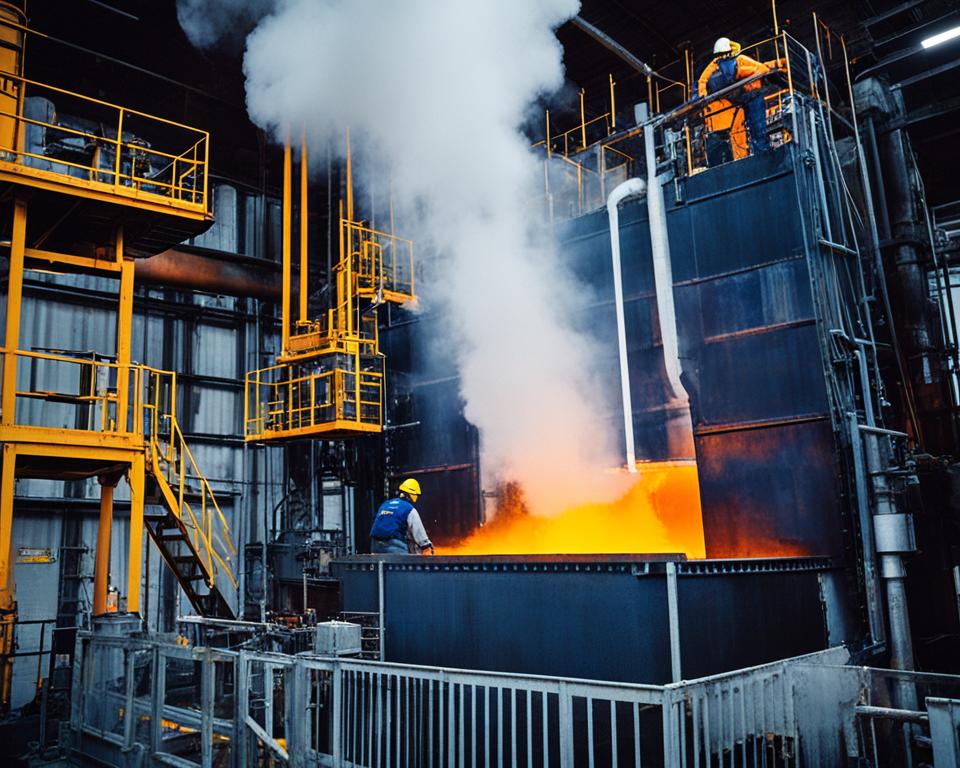
Quicklime plays a crucial role in the steel manufacturing process, offering numerous benefits that enhance efficiency and improve the quality of the final product. Through its unique properties, quicklime contributes to the removal of impurities and enables the production of high-quality steel.
One of the primary uses of quicklime in steel manufacturing is in the desulfurization process. Steel production often involves the use of iron ore, which contains sulfur impurities. These impurities can lead to brittleness and reduced strength in the final product. By introducing quicklime during the steel refining process, the sulfur impurities react with the quicklime to form calcium sulfide, which can be easily removed. This desulfurization process helps improve the mechanical properties and overall quality of the steel.
The use of quicklime also facilitates the removal of phosphorus, another common impurity in steel production. Phosphorus can negatively affect the performance and durability of steel. When quicklime reacts with phosphorus in the molten steel, it forms calcium phosphate, which can be separated from the steel. This phosphorus removal process helps increase the purity of the steel, resulting in improved mechanical properties.
In addition to impurity removal, quicklime aids in the formation of slag, a vital component in the steelmaking process. Slag acts as a protective layer, preventing oxidation and reducing heat loss during steel production. Quicklime assists in the formation of slag by reacting with impurities and other components present in the steel, resulting in a more efficient and controlled melting process.
“Quicklime is an indispensable component in steel manufacturing, enabling the production of high-quality, durable steel by effectively removing impurities and improving the refining process.”
Furthermore, quicklime offers benefits in terms of increased efficiency and cost-effectiveness in steel manufacturing. Its high reactivity and exothermic nature promote better heat transfer, allowing for faster and more efficient refining processes. This results in reduced production time and energy consumption, leading to cost savings for steel manufacturers.
Overall, quicklime’s versatile properties and significant role in the steel manufacturing process make it an indispensable component for producing high-quality steel. Its ability to remove impurities, facilitate slag formation, and enhance efficiency contribute to the production of strong and durable steel products for various applications.
| Benefits of Quicklime in Steel Manufacturing |
|---|
| Removal of sulfur impurities |
| Phosphorus removal |
| Facilitation of slag formation |
| Increased efficiency and cost-effectiveness |
Quicklime in Paper Production
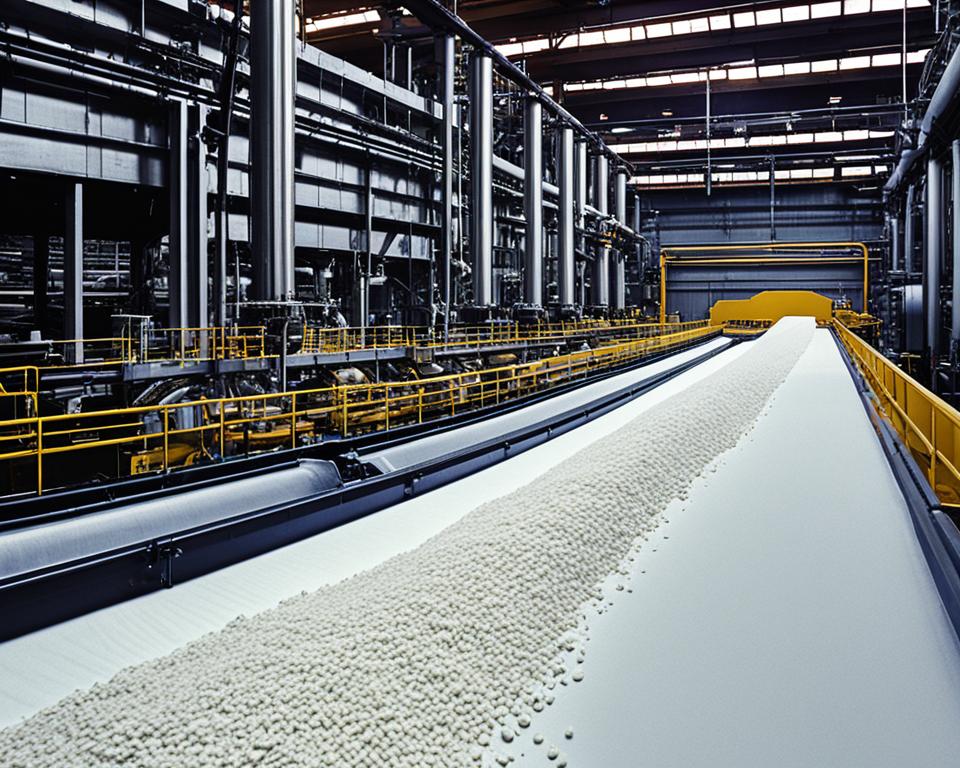
Quicklime plays a crucial role in the paper production industry, offering numerous benefits to enhance the quality and efficiency of the manufacturing process. Its versatile properties make it an essential component in pulp and paper processing.
When used in pulp production, quicklime helps improve the quality of the pulp by facilitating the separation of fibers and reducing impurities. It also enhances the strength and durability of the final paper product. The alkaline nature of quicklime aids in the removal of lignin, a complex polymer that binds fibers together, resulting in a higher-quality pulp.
In addition to enhancing pulp quality, quicklime is used to control pH levels during the papermaking process. It acts as a buffer, ensuring the ideal pH range necessary for effective paper formation and reducing the degradation of cellulose fibers. The controlled pH ensures optimal paper strength and stability, preventing premature deterioration.
Furthermore, quicklime aids in the bleaching process by helping to remove colorants and brighten the paper. Its use in bleaching agents not only enhances the visual appeal of the final product but also meets industry standards for brightness and whiteness.
Quicklime plays a crucial role in improving the quality, strength, and pH control in paper production.
| Benefits of Quicklime in Paper Production | Applications |
|---|---|
| Improved pulp quality | Pulp processing |
| Enhanced paper strength | Pulp processing |
| Controlled pH levels | Papermaking |
| Bleaching agent | Paper bleaching |
Overall, the use of quicklime in paper production offers significant advantages, including improved pulp quality, enhanced paper strength, controlled pH levels, and efficient bleaching. These benefits contribute to the production of high-quality paper products that meet the demands of various industries and consumers.
Quicklime in Chemical Processes

Quicklime, also known as calcium oxide (CaO), plays a crucial role in various chemical processes. Its versatility and reactivity make it a valuable component in the production of chemicals, including calcium hydroxide (Ca(OH)2), as well as in diverse chemical reactions and synthesis.
One of the significant uses of quicklime in chemical processes is its involvement in the manufacturing of calcium hydroxide. Calcium hydroxide, also known as slaked lime, has numerous applications in industries such as construction, agriculture, and water treatment. It is produced by adding water to quicklime, resulting in a chemical reaction that forms calcium hydroxide.
The chemical reaction between quicklime and water can be represented by the following equation:
CaO + H2O → Ca(OH)2
Calcium hydroxide has many uses, including as a building material, a pH regulator in water and wastewater treatment, and a reagent in chemical processes.
Quicklime is also utilized in a wide range of chemical reactions and synthesis. Its high reactivity allows it to act as a catalyst or reactant in various reactions. It can be used to neutralize acids, initiate chemical reactions, and facilitate the formation of desired compounds.
Furthermore, quicklime finds applications in the production of other chemicals, such as calcium carbonate (CaCO3) and calcium chloride (CaCl2). These compounds are used in industries such as manufacturing, construction, and water treatment.
The versatility of quicklime in chemical processes makes it an essential component in numerous industries. Its wide range of applications contributes to the production of various chemicals and the advancement of chemical synthesis. With its reactivity and usefulness, quicklime continues to play a vital role in shaping the chemical industry.
Conclusion
In conclusion, quicklime is a versatile and essential substance that finds applications in various industries. Its uses range from construction, water treatment, agriculture, and industrial processes.
Quicklime plays a crucial role in construction projects, contributing to mortar and plaster production as well as soil stabilization. It is also a key component in water treatment, helping to remove impurities and adjust pH levels in drinking water and wastewater treatment facilities.
In agricultural practices, quicklime aids in soil pH adjustment, nutrient enrichment, and pest control, promoting healthier and more productive crops. Additionally, quicklime is widely utilized in industrial settings, such as steel manufacturing, paper production, and chemical processes, where it enhances efficiency and quality.
The environmental benefits of quicklime use are not to be overlooked. It assists in reducing air pollution through flue gas desulfurization and controlling wastewater contaminants. Furthermore, quicklime is employed in waste management practices to stabilize hazardous waste and neutralize odors.
With its broad range of applications and contributions across various sectors, quicklime is a crucial component in modern society. Its versatility, reliability, and environmental advantages make it an indispensable resource for numerous industries.
FAQ
What are the uses of quicklime?
Quicklime has various applications across different industries. It is commonly used in construction, water treatment, agriculture, industrial processes, waste management, steel manufacturing, paper production, and chemical processes.
How is quicklime used in construction?
Quicklime plays a vital role in construction projects. It is used in the production of mortar and plaster, providing strength and durability to structures. Additionally, quicklime is utilized for soil stabilization and road construction.
What are the water treatment applications of quicklime?
Quicklime is essential in water treatment processes. It is used to remove impurities and adjust pH levels in drinking water and wastewater treatment facilities, ensuring safe and clean water for consumption and environmental protection.
How is quicklime used in agriculture?
Quicklime is used in agriculture for soil pH adjustment, nutrient enrichment, and pest control. It helps balance the acidity of soil, promotes healthy plant growth, and controls pests in farming and gardening practices.
How is quicklime utilized in various industries?
Quicklime finds its applications in various industrial sectors. It is used in steel manufacturing to remove impurities, increase efficiency, and improve the quality of steel. Additionally, it is used in paper production and chemical processes.
What are the environmental benefits of using quicklime?
Using quicklime offers several environmental advantages. It aids in reducing air pollution through flue gas desulfurization, which helps remove sulfur dioxide emissions. Quicklime also helps control wastewater contaminants, promoting cleaner water systems.
How is quicklime involved in waste management?
Quicklime plays a significant role in waste management practices. It is used to stabilize hazardous waste, neutralize odors, and facilitate proper waste disposal. Its absorption properties make it an effective tool in managing waste materials.
What is the role of quicklime in the steel manufacturing process?
Quicklime holds great importance in the steel manufacturing process. It is used to remove impurities, such as silica and phosphorus, from the steel. Quicklime also increases efficiency and enhances the quality of the final steel product.
How does quicklime contribute to paper production?
Quicklime plays a crucial role in the paper production industry. It is used in pulp and paper processing to improve pulp quality, enhance paper strength, and control pH levels. Quicklime helps achieve high-quality paper products.
What are the applications of quicklime in chemical processes?
Quicklime is widely used in various chemical processes. It is used in producing chemicals like calcium hydroxide. Quicklime facilitates chemical reactions and synthesis, making it an essential ingredient in chemical manufacturing.

